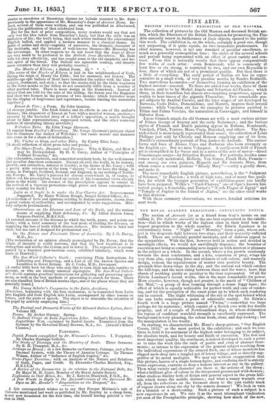FINE ARTS.
BRITISH INSTITUTION: EXHIBITION OF OLD MASTBBS.
The collection of pictures by the Old Masters and deceased British art- ists, which the Directors of the British Institution for promoting the Fine
Arts annually renew in furtherance of their objects, opened to the public this week. The exhibition is, on the whole, certainly a good one, though not surpassing, if it quite equals, its two immediate predecessors. Its chief feature, however, is not any standard of peculiar excellence, so much as a generally cosmopolitan tone ; the styles of the several schools and periods being represented with an effect of great variety and con- trast. From this it naturally results that there appear comparatively
few works of each artist : even Rembrandt, who is commonly at least five or six strong, is restricted to two, and our own Reynolds to
four, three of which are not of a prominent quality. But then there is a little of everything. The early period of Italian art has its repre- sentative in a small work, of very peculiar merits, by Sandro Botticelli. Two marvellous Leonardos—of themselves forming an exhibition of the highest interest—succeed. To these are added four works, three of them in fresco, said to be by Michel Angelo and Sebastian del Piombo ; which three, in their beautiless but almost awe-inspiring proportions appear in reality to bear traces of the gigantic Florentine. Two remarkable gos- pel subjects by Annibal Caracci, and the later stages of art developed by Baroccio, Carlo Dolce, Domenichino, and Maratti, impress their several lessons; while Venetian art has its examples in pictures ascribed to Titian and Palma Vecchio, the naturalisti in Caravaggio, and himself in Salvator Rosa.
Lucas Cranach stands for old German art with a most curious picture of Prince George of Saxony and the early Reformers ; and the various styles of Flemish and Dutch painting appear in Itubens, Rembrandt,
Vandyck, Flink, Teniers, Maas, Cuyp, Ruysdael, and others. The Spa- nish school is more largely represented than usual; the collection of Louis
Philippe just sold by Christie and Manson supplying one of its lions, Murillo's extraordinary portrait of Don Andrea de Andrade. The austere forms and hues of Alonzo Cano and Zurbaran also loom strangely on the English eye. But we miss Velasquez. A rarely-seen field of French art is exemplified in Le Sueur and in a series of the acts of mercy—direct Poussinesquc essays—by Sebastian Bourdon. For portraits, besides some names already mentioned, Holbein, Van Somer, Frank Hals, Franck— and among our own painters, Hogarth and Sir Antonio More, from whom comes a second glorious "Bloody Mary"—certify a goodly show, and make it.
The most remarkable English picture, nevertheless, is the " Judgment of Solomon," by Hayden ; a work of high tone, and of many fine quali- ties, for which the younger generation of exhibition-goers can hardly have been prepared. Wilkie's " Card-Players," one of Opie's known his- torical groups, a Constable, and Turner's "Tenth Plague of Egypt" and "Temple of Jupiter in the Island of 2Egina," are the other chief works in this division.
With these summary observations, we reserve detailed criticism for next week.
























 Previous page
Previous page